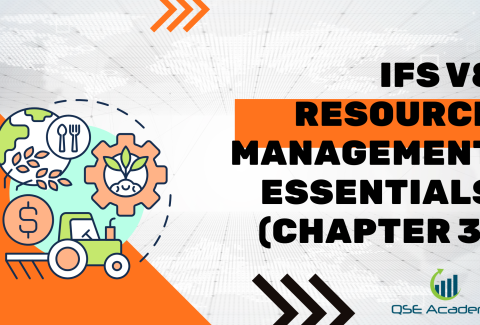IFS V8 Governance & Commitment Requirements (Chapter 1)
Last Updated on November 17, 2025 by Melissa Lazaro
Why Governance and Leadership Commitment Matter
Here’s what I’ve noticed after years supporting food manufacturers through IFS audits: companies rarely fail because they don’t know food safety. They fail because leadership can’t demonstrate their role in it.
IFS V8 made governance and commitment more explicit and measurable. It’s no longer enough to have policies signed once a year or to say, “We support food safety.” Auditors expect proof that leadership is actively involved, informed, and accountable.
By the time you finish this guide, you’ll understand:
- What IFS V8 expects from senior leadership
- How to structure governance so it’s visible and audit-ready
- Simple ways to document involvement without adding unnecessary bureaucracy
- Common mistakes companies make—and how to avoid them
If you’ve ever wondered, “How much involvement is enough?” or, “What evidence will the auditor ask for?”—you’re in the right place.
Understanding Governance in IFS V8 — Leadership Accountability and Structure
Governance under IFS V8 isn’t about hierarchy charts or legal terms. It’s about clarity.
Who’s accountable for food safety decisions? Who escalates risks? Who approves resources?
A strong governance structure answers those questions clearly and consistently.
A simple way to approach it:
Break governance into these elements:
- Roles and responsibilities
- Decision-making authority
- Communication flow
- Escalation processes
- Monitoring and review
In my experience, having a clear RACI matrix is one of the easiest ways to avoid confusion. It shows who leads, who supports, and who signs off.
Common gap I see: policies say one thing, but on the floor, people describe roles differently.
A client once told me, “Everyone knows who handles recalls.” But when the auditor asked three employees, they each named a different person. The company didn’t fail on competence—it failed on clarity.
Pro tip:
Review governance annually and after any major change—management restructuring, new certification scope, or new product category.
 Policy Requirements — Food Safety and Quality Policy Expectations
Policy Requirements — Food Safety and Quality Policy Expectations
Policies set the direction. They shouldn’t read like legal documents; they should tell people what the business stands for.
IFS V8 requires two core policies:
- Food Safety Policy
- Quality Policy
Both must be:
- Relevant to your site and processes
- Communicated and understood internally
- Approved and reviewed by top management
- Linked to business objectives, KPIs, and continual improvement
A quick test I use:
If you hand the policy to a line operator, can they explain what it means for their job?
If the answer is no, the policy is too generic.
A mistake I see often: downloading a template from online and changing only the company name. Auditors notice immediately because it won’t mention your processes, risks, or customer expectations.
Pro tip:
Link the policies to:
- Training programs
- Internal audits
- Risk assessment outcomes
- Management review findings
That’s how you make the policy meaningful—not just present.
Leadership Engagement — Evidence of Active Involvement
Leadership engagement is where most companies feel the pressure. But engagement doesn’t mean senior managers need to walk the factory floor every day or sit in every meeting.
What auditors want to see is:
- Decision-making supported by evidence
- Visible participation in key food safety activities
- Consistent follow-through on commitments
Some examples of acceptable evidence:
- Signing and reviewing KPIs during management review
- Participating in internal audit closing meetings
- Approving resources linked to risk or improvement
- Being present during recall simulations
- Conducting short documented “leadership walk-throughs”
One client improved their score dramatically just by implementing a monthly 15-minute “leadership visit.” They didn’t overcomplicate it—they used a simple form showing observations, questions asked, and actions taken.
That’s engagement auditors trust.
Management Review Expectations — Inputs, Outputs, and Timing
Management review shouldn’t be a formality. It’s a performance evaluation of the food safety and quality system.
IFS V8 expects you to review:
- Objectives and KPI performance
- Internal audit results
- Customer complaints and feedback
- Non-conformities and CAPA status
- Resource needs
- Supplier performance
- Legal and regulatory changes
- Recall test results
A common mistake is doing the review only before the audit, which makes it feel rushed. Conducting it too late removes time for actions to be implemented and verified—something auditors check.
Pro tip:
Create a standing agenda aligned with IFS requirements.
That way, you’re always prepared for an audit—not scrambling.
Legal and Customer Requirements — Compliance Ownership and Monitoring
Compliance isn’t static. Regulations change, customer requirements evolve, and specifications are updated often.
IFS V8 expects companies to:
- Maintain a documented legal register
- Review it regularly
- Assign ownership for updates and communication
- Implement changes through controlled processes
The easiest way to stay compliant is to assign responsibility to a named role—not “the food safety team.” Accountability must sit with someone identifiable.
A frequent pitfall is informing employees verbally about changes without updating documents or training evidence. In audits, undocumented actions are treated as if they never happened.
Resource Provision — Skills, Budget, and Infrastructure
Top management must show they provide the resources needed to protect food safety and quality.
This applies to:
- Training and competency development
- Equipment maintenance and calibration
- Facility improvements
- Software and documentation systems
- Staffing levels
If internal audits, complaints, or KPIs highlight resource gaps—and leadership doesn’t respond—auditors will raise a major non-conformity.
Documented decisions show commitment. Even a simple annotated budget line or email trail can demonstrate compliance.
FAQs
1. How visible does leadership involvement need to be during the audit?
Visible enough that evidence confirms decisions, participation, and follow-through—not just signatures.
2. Can one person represent top management during the audit?
Yes, as long as leadership involvement is documented across the year—not only during the audit.
3. Are generic policies acceptable if the company follows them?
No. Policies must reflect your specific operations, risks, and customer expectations.
Conclusion — Turning Governance Into Action
Strong governance isn’t something you create the week before the audit. It’s built gradually through structure, documentation, and consistent leadership behavior.
When top management is informed, engaged, and accountable, audit readiness becomes easier—and operational performance improves naturally.
If you’re ready to simplify this process, the next step is to review your governance evidence. Start with policies, roles, and management review—and build from there.
Melissa Lavaro is a seasoned ISO consultant and an enthusiastic advocate for quality management standards. With a rich experience in conducting audits and providing consultancy services, Melissa specializes in helping organizations implement and adapt to ISO standards. Her passion for quality management is evident in her hands-on approach and deep understanding of the regulatory frameworks. Melissa’s expertise and energetic commitment make her a sought-after consultant, dedicated to elevating organizational compliance and performance through practical, insightful guidance.








